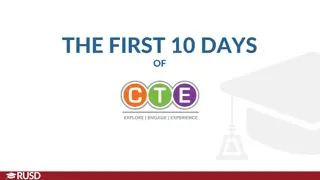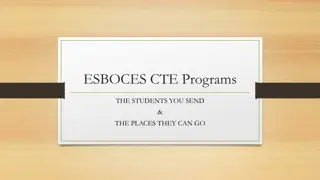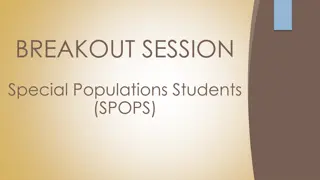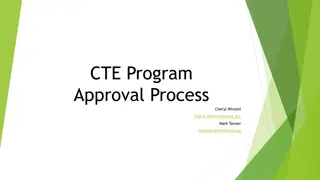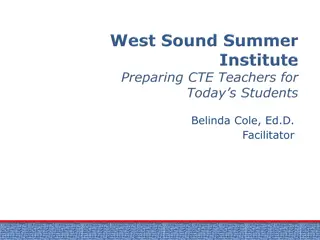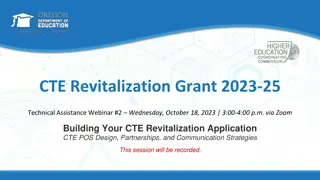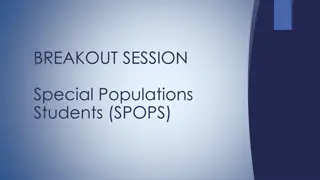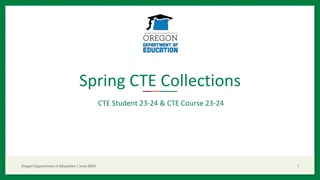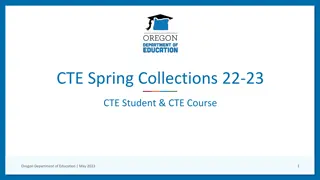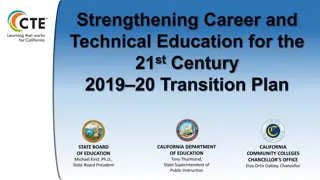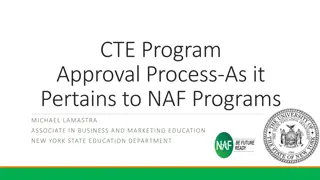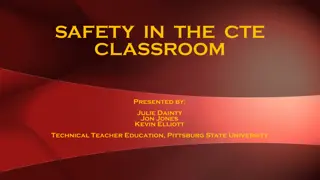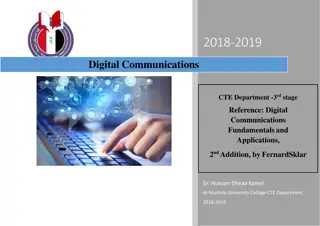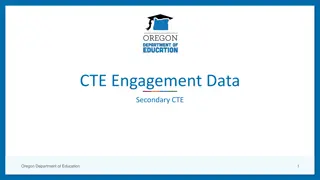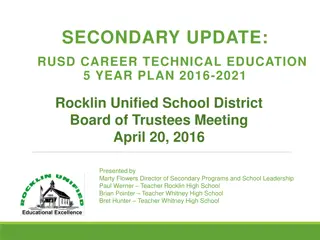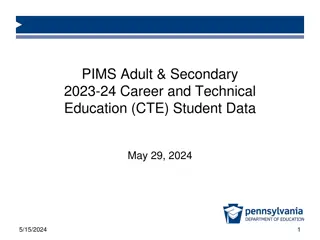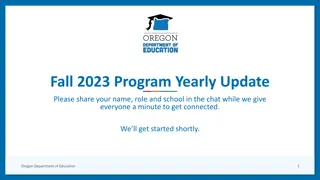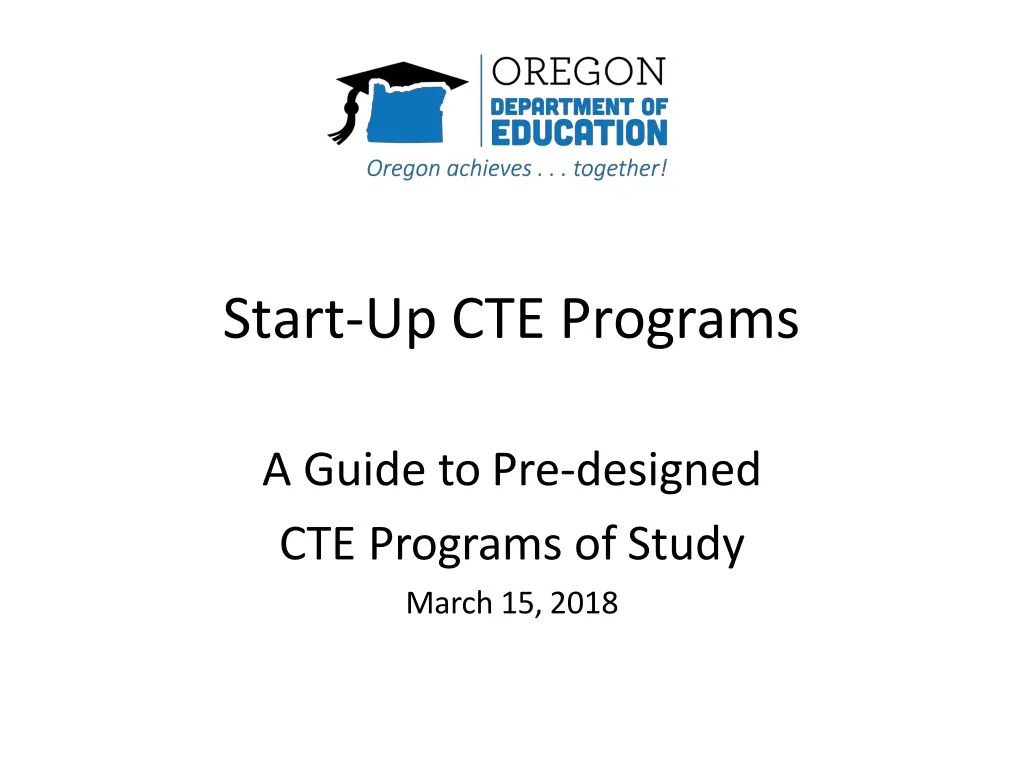
Guide to Starting CTE Programs - Essential Steps and Resources
Discover how to initiate a Career and Technical Education (CTE) Program effectively in your school or district. Learn about key considerations, available resources, and the phased approach to developing a high-quality CTE Program of Study. Find out how to align courses with industry standards, support student success, and leverage funding opportunities for sustainable growth.
Uploaded on | 0 Views
Download Presentation

Please find below an Image/Link to download the presentation.
The content on the website is provided AS IS for your information and personal use only. It may not be sold, licensed, or shared on other websites without obtaining consent from the author. If you encounter any issues during the download, it is possible that the publisher has removed the file from their server.
You are allowed to download the files provided on this website for personal or commercial use, subject to the condition that they are used lawfully. All files are the property of their respective owners.
The content on the website is provided AS IS for your information and personal use only. It may not be sold, licensed, or shared on other websites without obtaining consent from the author.
E N D
Presentation Transcript
Start-Up CTE Programs A Guide toPre-designed CTE Programs of Study March 15,2018
Welcome to Career and Technical Education CTE We are excited that you have decided to explore how to start a CTE Program in your school or district. Under the High School Graduation and College and Career Readiness Act of 2016, direct funding will be provided to Oregon school districts to increase high school graduation rates. Measure 98 identifies three specific areas: 1. 2. Establish or expand career and technical education programs in high schools, Establish or expand college-level educational opportunities for students in high schools,and Establish or expand dropout-prevention strategies in high schools. 3.
Real Options for College and Rewarding Careers CTE Delivers forStudents Real World Skills Real High School Experience with More Value courtesyof
If youre thinking of starting a Program of Study, here are important things to consider: Have you contacted your Regional CTE Coordinator for help in getting started? The Regional Coordinators are the key to successful CTEProgramming! What programs/courses does your district already have in place that can beleveraged? Does the career area you are identifying follow the high wage, high demand labor marketinformation for your region?
Model CTE Program of Study Phase I: Phase I! I: Phase II ! I : CTE Program of Study High Quality CTE Programs Start Up CTE Program Sequence of contextualized and hands-oncourses (atIeast2 credits) aligned with industry approved skill set. Intentioral and phased-in development of a sequence of courses leading to a CTE Program of Study. Meets or exceeds all components of a CTE Program of Study. Includes a sequence of courses (3 or more credits) in grades 9 14 resulting in an industry credential. Could take up to three years to reach a full CTE Program of Study. Includes careerguidance and support for studentsuccess. Programs lead to a high wage and high demandoccupation. The district should include the CTE Regional Coordinator in planning a Start UpCTEProgram of Study. A professional development plan is requiredto ensurecontirzJous program improvement and Student Leadership Organizations are an integral part of a CTE Program ofstudy. Potential Resources Potential Resources Potential Resources Localsource Eligible for M98 funds to expand Supplemental Perkins Federalfunds Localsource Eligible forM98 funds to expand Secondary Career Pathways Supplemental Perkins Federal funds Localsources Eligible forM98 funds Supplemental Perkins funds OREGON DEPARTMENT OF EDUCATION 3/1/17
More Important Considerations: Do you have an instructor identified? What kind of equipment and materials do you need? Will your program be affiliated with a student leadership organization (CTSO)? Are you planning to offer college credit in the Program ofStudy?
Career Learning Areas and Sample Programs toConsider: Agriculture, Food & Natural ResourcesSystems Agribusiness Systems AgriculturalScience & Technology Environmental Service Systems Forestry & Forest Products NaturalResource Systems Arts, Information &Communications Digital Media Production Information & Communications Technology Performing Arts Programming & Software Development Business &Management Business Management & Administration Finance & Accounting Hospitality Tourism (Culinary, Travel, Lodging) Marketing & Entrepreneurship
Career Learning Areas and Sample Programs toConsider: (continued .) HealthSciences Biotechnology Research & Development Diagnostic Services Health Informatics TherapeuticServices HumanResources Education & Training Family & Community Services Human & Personal Care Services Law, Public Safety, & Security Industrial & EngineeringSystems AdvancedManufacturing Automotive & Heavy Equipment Technology Construction Technology EngineeringTechnology
Agriculture, Food & Natural Resources Systems Agriculture Science & Technology The Agriculture Science & Technology Program of Study is a comprehensive program that connects the related career strands that are part of the vibrant nature of Oregon s agriculture industry. The career strands include agribusiness, animal science, plant science/horticulture, and agriculture mechanics. A focus on agriculture entrepreneurship, leadership, and management skills is part of the program. Students who are enrolled within the Agriculture Science and Technology Program of Study are eligible to participate within the FFA student leadership organization (CTSO).
AGRICULTURE SCIENCE & TECHNOLOGY START-UP PLAN Course 1 BasicSkills Introduction to Agriculture Science Agriculture Science Course 1 BasicSkills Introduction to Course 2 AdvancedSkills AnimalScience/Plant Science/Horticulture Science/Horticulture Course 2 AdvancedSkills AnimalScience/Plant Course 3 Course 3 Agriculture Mechanics Agriculture Mechanics Introduction to mechanicaltheory Safety Selection of powertools Electricalwiring Plumbing Hydraulics Mechanicalengines Buildingmaterials Welding Cold metal workingtools Automationsystems Precisionagriculture FFA FFA Introduction to mechanicaltheory Safety Selection of powertools Electricalwiring Plumbing Hydraulics Mechanicalengines Buildingmaterials Welding Cold metal workingtools Automationsystems Precisionagriculture Taxonomy Hands-oneducation Projects andactivities Characteristicsof plant/animal science Productionproblems Solvingproblems Communicating Engagement with business and industry FFA FFA Taxonomy Hands-oneducation Projects andactivities Characteristicsof plant/animal science Productionproblems Solvingproblems Communicating Engagement with business and industry Animalhusbandry Plantscience/horticulture Mechanicalskills Automationsystems Precisionagriculture Agribusinessrecordkeeping Leadership PublicSpeaking Parliamentaryprocedure Agriculturalsafety Intra-personalskills Introduction toFFA Introduction toFFA Animalhusbandry Plantscience/horticulture Mechanicalskills Automationsystems Precisionagriculture Agribusinessrecordkeeping Leadership PublicSpeaking Parliamentaryprocedure Agriculturalsafety Intra-personalskills Leadershipskills Next step tocareer Preparationforcollege opportunities Farm/Ranch/Rangeland managementpractices FFA FFA Leadershipskills Next step tocareer Preparationforcollege opportunities Farm/Ranch/Rangeland managementpractices Advanced SynthesisCourse Entrepreneurship Financialmanagement Recordkeeping Agribusinessmanagement Farmsteadlayout Farmstead layout Course4 Agribusiness Management Entrepreneurship Financial management Record keeping Agribusiness management Tolearn more, or get started, please contact your Regional CTECoordinator
Agriculture, Food & Natural Resources Systems Forestry & Forest Products The Natural Resources/Forestry Program of Study reflects the career opportunities within Oregon s diverse natural resource industries. The focus on natural resources/forestry production, management, and leadership skills is reinforced within the program. Students enrolled within the Natural Resources/Forestry Program of Study are eligible to participate within the Future Natural Resource Leaders (FNRL) student leadership organization (CTSO).
FORESTRY & FOREST PRODUCTS START-UP PLAN Course 1 BasicSkills Course 2 AdvancedSkills Natural Resource System Management Course3 Careers Introduction to Natural Resources/Forestry Natural Resources/ Forestry Advanced SynthesisCourse Personal careerinterest Student sindividualizedlearning plan Careeropportunitiesin the local and regional employmentsector Leadershipskills Next step tocareer Preparationforcollege opportunities FNRL Plantidentification Navigationtools Mapreading/interpretation Toolusage Rangelandresources Silviculture Dendrology Heritage of Oregon sforests Resourceutilization Economicneeds Recreation/tourism Components ofsustainability Introductionto FNRLstudent leadership FNRL Advanced SynthesisCourse Management/ResourceUtilization Economy ofResources Internalandexternalfactors in the environment Sustainability Role of managementstrategies Understandingof healthynatural resourcesystems Issues associated with resources management Utilization of publiclands FNRL To learn more, or get started, please contact your Regional CTE Coordinator
Arts, Information & Communications Information Technology/Computer Science This sequence of courses prepares students for pathways into computer technology-related industries. Students will increase their level of understanding in applying skills that are relevant to local and national entry-level positions, as well as college-ready academic skills. A successful program framework should include flexibility for focus on the various techniques seen in the industry, such as coding languages, and hardware and software design structures.
INFORMATION & COMMUNICATIONS TECHNOLOGY START-UP PLAN High Quality Perkins to High Wage, High Demand Career, Year3 Start-UpProgram Year1 Perkins Program of Study Year2 Designed for beginning structural programming, webpage design, and programminglanguage Examplecourses: Web Design1 Computer Game Design1 Deeper understanding of programming language, including graphics, circuit design, game design, app development Examplecourses: Web Design2 Computer Game Design2 Job shadow orsite visit Advanced topics such as AI, UX design, and advanced graphics Examplecourses: Java Programming CS 161 - PSU Credit (full- yearcourse) Internship This POS could be a 3-year pathway offering 3 credits, including 1 dual college credit and career related learning experiences Tolearn more, or get started, please contact your Regional CTECoordinator
Arts, Information & Communications Web & Digital Media Production This sequence of arts-based design courses prepares students for pathways into modern digital media industries. Students will have the chance to grow their basic skills to an advanced level of design and production while connecting their academic skills and learning valuable workplace-ready skills. A program framework should include flexibility for focus on the varied creative methods and skills used in the industry, such as digital design, editing, and production.
DIGITAL MEDIA PRODUCTION START-UP PLAN High Quality Perkins to High Wage, High Demand Career, Year3 Start-UpProgram Year1 Perkins Program of Study Year2 Advanced editing techniques, lighting, sound, photography, creating industry quality videos Examplecourses: Advanced Digital Media: Web and Video Design Internship Deeper understanding of tools, materials, technical knowledge, skills, and expression of aesthetic vision Examplecourses: DigitalMedia Production3 DigitalMedia Production4 Job shadow orsite visit Designed for learning basic ICT tools, operations forcommunication,roles of creators in production, and presentation of visual and mediaarts Examplecourses: Digital Media Production1 Digital Media Production2 This POS could be a 3-year pathway offering 3 credits, including 1 dual college credit and career related learning experiences Tolearn more, or get started, please contact your Regional CTECoordinator
Business & Management Business Management & Administration (BMA) The BMA CTE Program of Study focuses on the business needs of Oregon's students as they prepare to enter and succeed in the world of business. The careers in this area span virtually every industry in the world. Studies in Business & Management focus on the commonalities among most businesses, including concepts like personnel management, marketing, planning, finance, and resource management.
BUSINESS MANAGEMENT & ADMINISTRATION (BMA) START-UPPLAN High QualityPerkins High Wage, High Demand Career, Year3 Start -UpProgram, Year 1, One Course Perkins Program of Study, Year 2, Add Courses BusinessManagement Principles 2 (semester) and Entrepreneurship 2 (semester) Technical SkillAssessment Job shadow or sitevisit Internship FBLA Business Management Principles 1 (semester) and/or Entrepreneurship 1 (semester) FBLA Intro to Business 1 (semester) and/or Intro to Business2 Future Business Leaders of America(FBLA) This POS could be a 3-year pathway offering 3 credits, including 1 dual college credit and career related learningexperiences Tolearn more or get started, please contact your Regional CTE Coordinator
Business & Management Marketing & Entrepreneurship The Marketing & Entrepreneurship CTE POS is focused on students in Oregon who anticipate they will be launching businesses in their community and need to be versed not only in the skills of their industry, but on how to run a business in that industry. This program stands on its own for students who see themselves providing business expertise to start-up businesses in their community; It also prepares students interested in Marketing careers; and thirdly, it stands as a complement to other Programs of Study in which students think they might want to start or operate small businesses in their own career field.
MARKETING & ENTREPRENEURSHIP START-UP PLAN High QualityPerkins High Wage, High Demand Career, Year3 Perkins Program of Study, Year 2, Add Courses Start-UpProgram, Year 1, One Course Business Management Principles 1 (semester) and Entrepreneurship 3 (sem) Marketing 3 Technical SkillAssessment Job shadow or sitevisit Internship DECA Entrepreneurship 2 (semester) and Marketing 2 (semester) DECA Entrepreneurship 1 (semester) -and/or Marketing 1 DECAorganization This POS could be a 3-year pathway offering 3 credits, including 1 dual college credit and career related learningexperiences Tolearn more or get started, pleasecontactyour Regional CTECoordinator
HealthSciences Therapeutic Services The Health Sciences Therapeutic Services Program of Study prepares students for pathways into all health care careers. Following national health science standards, completion of this Program of Study provides usable knowledge and skills that carry to further training at community colleges and universities. Students enrolled in the Health Sciences Therapeutic Services Program of Study are eligible to participate within the Future Health Care student leadership organization.
THERAPEUTIC SERVICES START-UP PLAN Course 1 Course 2 Health SciencesI Course 3 Health SciencesII Health Occupations Exploration of HealthCareers Ethicswithincultural,social, and ethnicdifferences Medical mathprinciples Methods of deliveringand obtaininginformation Communicatingeffectively Employabilityskills HOSA (Future Health Professionals) How key systems affect services performed and quality ofcare Health maintenancepractices Informationtechnology Technicalskills HOSA Legalresponsibilities Safetypractices Humananatomy/physiology Common diseases anddisorders Teamwork/Roles and responsibilities of individual membersas partof the healthcareteam This course requires a Technical Skill Assessment(TSA) Communications Employabilityskills Safetypractices Teamwork Technicalskills Course 4 SeniorCapstone Work-Based Learning(WBL) CareerPracticum Tolearn more, or get started, please contact your Regional CTECoordinator
HealthSciences Biotechnology Research & Development The Health Sciences Biotechnology Research & Development Program of Study prepares students for pathways into all health care careers with an emphasis to develop technologies and products that help improve our lives and the health of our planet. Following national health science standards, completion of this Program of Study includes dual credit options for continuance of training at community colleges and universities. Please Note: The Oregon Department of Education does not endorse curriculums. However, following is an example of how one Oregon high school developed Project Lead the Way (PLTW) courses into an Oregon Health Sciences Program of Study.
BIOTECHNOLOGY START-UP PLAN * Course 1 Course 2 Course 3 BiomedicalScience Human BodySystems MedicalInnervations Healthcare deliverysystems Legal responsibilities and implications Legalpractices Ethicalpractice Common safetyhazards Emergencyproceduresand protocols Humananatomy/physiology Medicalmathematics Communicatingeffectively Medicalterminology Written communicationskills Infectioncontrol Basic computerskills Diseases anddisorders Healthybehaviors Cultural,social andethnic diversity Personalsafety Environmentalsafety Technicalskills Keyprinciplesofhealth informationsystems Privacyandconfidentiality of healthinformation Personal traits of a healthcareprofessional Career decisionmaking Employabilityskills Employability preparation Team member participation Course 4 Computer Science Principles * This information is provided as a courtesy case study of how the Health and Science School inBeaverton uses Project Lead the Way. For more information, visit Health and Science School CTE Program Listing. Health and Science School CTE Program Listing http://www.ode.state.or.us/data/stats/opte/ApprPrgs.aspx?school=00004638year=2017 http://www.ode.state.or.us/data/stats/opte/ApprPrgs.aspx?school=00004638&year=2017 To learn more, or get started, please contact your Regional CTE Coordinator
Human Resources Education & Training An Education & Training Program of Study may be one of the simplest to implement, as many high schools have much of the infrastructure needed for a POS in this area already in place. An Education & Training POS aligns with Oregon s industry need to develop secondary and CTE teachers, and prepares students to enter into the teacher preparation pipeline in Oregon. An Education & Training POS can be used in conjunction with other CTE POSs to help students develop careers teaching or training in their chosen career pathway.
EDUCATION & TRAINING START-UP PLAN Course2 AdvancedSkills: Teaching Profession Course3 Course1 Workplace Experience: (Teacher s Aide/Assistant) Basic Skills: Leadership Focus on helping students learn to establish a positive climate to promote learning, as well as foundation skills to maintain relationships with others in an effortto increase support for the organization EducatorsRising Family, Career and Community Leaders of America(FCCLA) SkillsUSA Focus on providing students the basics of developmental theory and introduction to the teachingprofession Students learn about standards, instruction, classroom instruction, and assessment EducatorsRising FCCLA SkillsUSA Focus on practicum experience, providing students the opportunity to use knowledge and skills to assist classroom teacher to plan and prepare effective instruction, develop standards-based goals, and assistin the promotionofa positive learning environment EducatorsRising FCCLA SkillsUSA To learn more, or get started, please contact your Regional CTE Coordinator
Industrial & Engineering Systems Advanced Manufacturing This sequence of courses prepares students for pathways into modern manufacturing and engineering industries. Students will have the chance to grow their basic skills to an advanced level of design and production while developing their academic and workplace skills. A program framework should be flexible to focus on the various materials seen in the industry, such as woods, metals, or mixed materials.
ADVANCED MANUFACTURING START-UP PLAN Course 1 BasicSkills Course 2 AdvancedSkills Course 3 ManufacturingProcesses Focus is on design and production of products that require integration ofskills The goal is to simulate a production facility SkillsUSA Focus is on building existingskills,with development of 3D design and technology enhanced processes, such asCNC SkillsUSA Focus is on using basic tools for design, layout, andproduction Manual processes are emphasized, as well as 2Ddesign SkillsUSA To learn more, or get started, please contact your Regional CTE Coordinator
Industrial & Engineering Systems Construction Technology The Construction Technology program prepares students for pathways into construction, architecture, and civil engineering. A student will be able to develop skills needed to design and build structures starting with basic tools and plans moving into larger projects where students are involved in the design. A design/build project that integrates a variety of materials and construction methods can range from new house construction to smaller structures such as sheds.
CONSTRUCTION TECHNOLOGY START-UP PLAN Course3 Course1 Course 2 AdvancedSkills Integrated Construction Projects Basic Tools and Design Focus is onbuilding construction anddesign Students advance knowledge and skills in construction carpentry focused on framing, stairs, roofing, siding,etc. Students create plans for projects that integrate these concepts using architectural design softwareand technology SkillsUSA Focus is ondeveloping skills in using basic woodworking tools and techniques through a series of small projects that can be completed in a shop Students experience design by reading and creating drawings for their projects SkillsUSA Focus is to provide students with a more in-depth look at the design/build industry Students use previously learned skills to work on full structures that can range from full houses to smaller site-built projects, such as gazebos orsheds SkillsUSA To learn more, or get started, please contact your Regional CTE Coordinator
Industrial & Engineering Systems Engineering Technology The Engineering Technology program prepares students pathways into engineering or engineering technician careers. Students use design processes and tools to develop prototypes for solutions to a variety of problems. The program culminates in a capstone course where students work in teams to identify their own problems and solutions.
ENGINEERING TECHNOLOGY START-UP PLAN Course1 Course3 Course 2 Basic Engineering Processes Advanced Engineering Design EngineeringDesign Focus is on identifying problems that can be solved using engineering principles and developing solutions Students work in teams to develop a working prototype oftheir ownsolution and communicate their design to review teams, simulating the way engineering happens in realsettings SkillsUSA Technical Student Association(TSA) Focus is onfundamental concepts inengineering Students learn about mechanical and electrical systems through a variety of short-term, defined projects Students also use design tools to communicate theirsolutions SkillsUSA Technical Student Association(TSA) Focus is on working in teams to design solutions to posed problems that increase incomplexity Students create drawings and prototypes that show proof of concept and communicate their solutions to otherteams SkillsUSA Technical Student Association(TSA) To learn more, or get started, please contact your Regional CTE Coordinator
Resources List of Regional CTE Coordinators: http://www.oregon.gov/ode/learning- options/CTE/resources/Pages/CTE-Network.aspx ODE Contacts by Career Learning Area: Agriculture, Food and Natural ResourcesSystems: Reynold Gardner Arts, Information andCommunications: Denise Brock Business andManagement: RonDodge HealthSciences: ArtWitkowski HumanResources: Jim Taylor Industrial and EngineeringSystems: TomThompson reynold.gardner@ode.state.or.us denise.brock@ode.state.or.us ron.dodge@ode.state.or.us art.witkowski@ode.state.or.us jim.taylor@ode.state.or.us tom.thompson@ode.state.or.us

